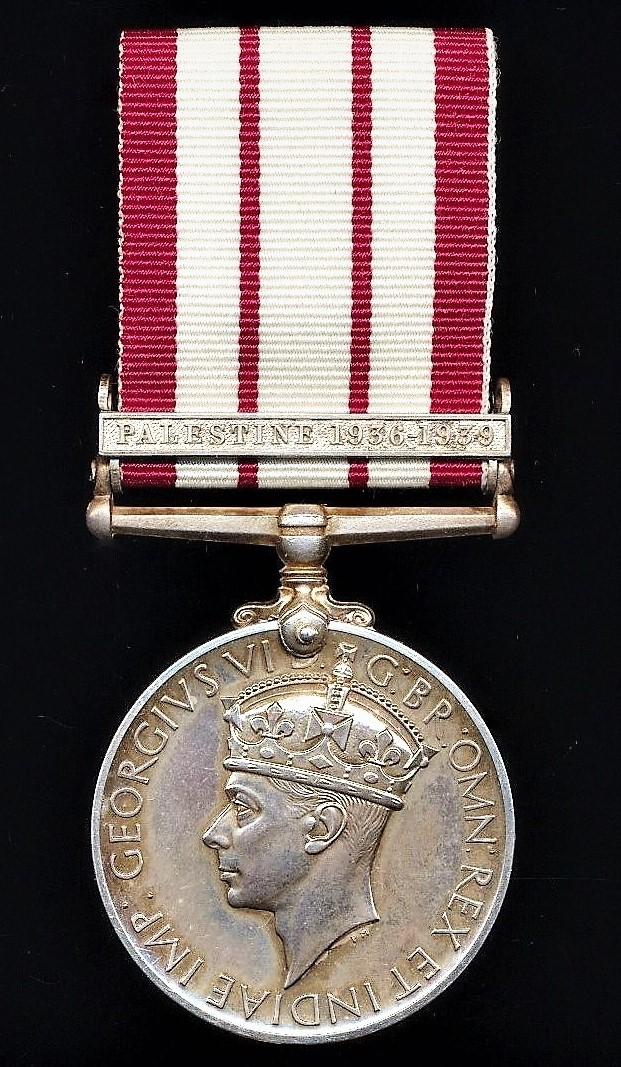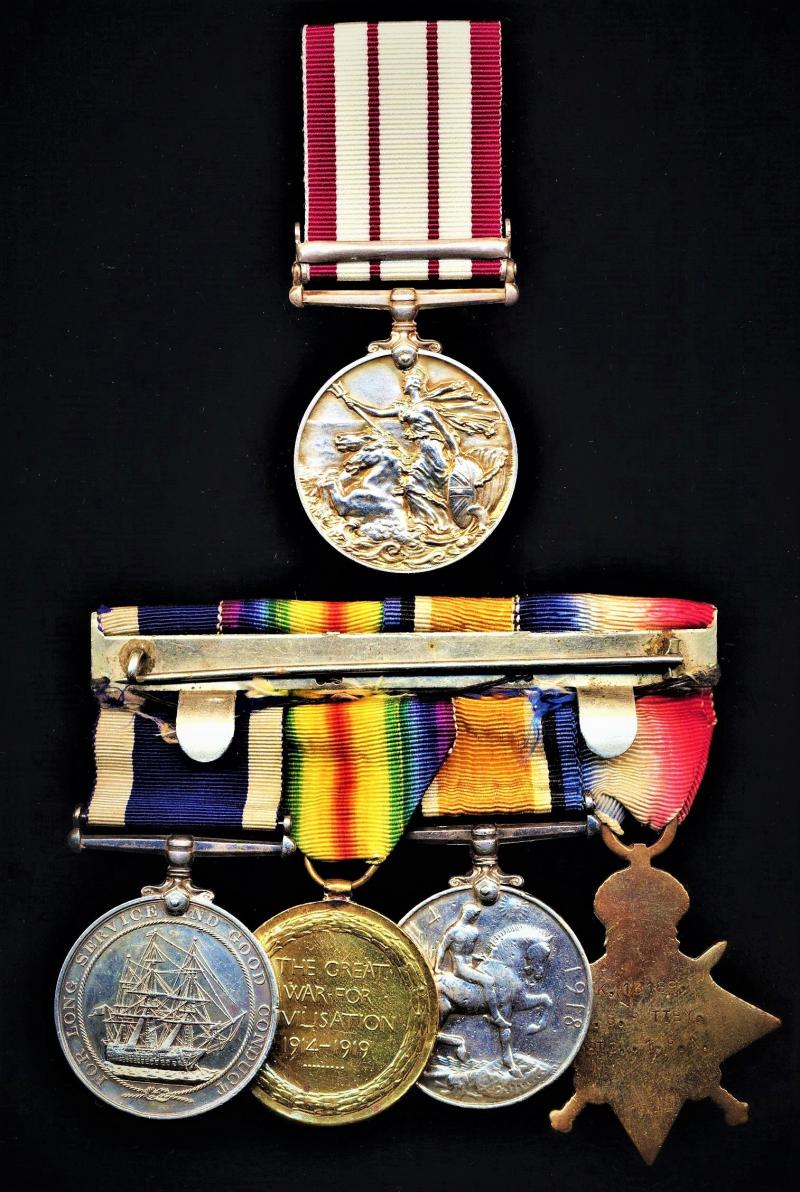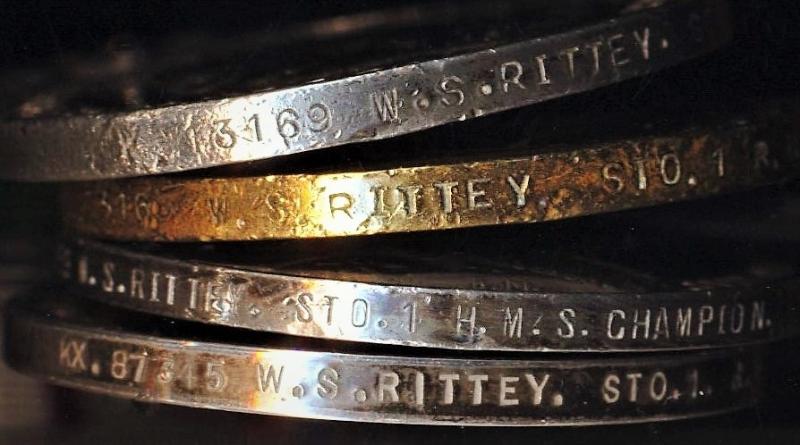A Naval group of 5 x medals to a survivor of sinking of H.M.S. Paragon, who later served in the Palestine Mandate Territory, during the Arab Rebellion 1936-39: Stoker William Stevens Rittey, Royal Navy
- 1914-15 Star (K.13169, W. S. Rittey, Sto., 1. R.N.)
- British War Medal. Silver (K.13169 W. S. Rittey, Sto. 1 R.N.)
- Interallied Victory Medal (K.13169 W. S. Rittey, Sto. 1 R.N.)
- NGS 1915. GVI 'Palestine 36-39' (KX .87345 W. S. Rittey, Sto. 1 R.N.)
- RN LSGC. GV 2nd type (K.13169 W. S. Rittey, Sto. 1 H.M.S. Champion)
Survivor of Sinking: Recipient was a survivor of the crew of H.M.S. Paragon, when on 17 March 1917, the Destroyer was sunk by torpedo in the Dover Strait in an action with enemy 'Kriegsmarine' Torpedo-Boats. An estimated 67 men were killed or subsequently died, with only 10 of the crew - including Stoker William Rittey - surviving the destruction of the ship
The Great War and Long Service medals verified on the respective medal rolls as under:
- 1914-15 Trio: Ref ADM 171/113 - sent to recipient at H.M.S. Truant
- RN LS&GC: Ref ADM 171/141 - medal traced 13/12/1926
William Stevens Rittey, son of Joseph Rittey (Building Contractors Foreman & Army Pensioner) and Claudina Rittey (nee Stevens), was a native of, Portsmouth, Hampshire, England, where he was born on, 11 October 1893. Prior to joining the Royal Navy, William had been employed as a 'Blacksmith'. William joined the Royal Navy on 10 November 1911. He was advanced to Stoker First Class, H.M.S. Revenge in February 1913. During the Great War he served in the Acasta Class Destroyer H.M.S. Paragon, (between 1 July 1916 to 15 February 1919). which ship was destroyed, and sunk, by enemy action on 17 March 1917. William was awarded a war gratuity for service, and in 1926 was awarded a Naval Long Service Service and Good Conduct Medal, after completing 15 years unblemished service. William married Gladys Louise Duncan, at Portsmouth, Hampshire, England. sometime during the first quarter of 1927. As a civilian seafarer, William sailed for a period in the 1930's with the British Merchant Navy, however he is recorded as re-joining the Royal Navy in November 1935 - with number KX. 87345 - as a pensioned Stoker First Class. William Stevens Rittey, is recorded as having died at Portsmouth, Hampshire, England, on 24 February 1964
H.M.S. Paragon: HMS Paragon was an Acasta-class destroyer that served in the Royal Navy during the First World War. She was launched in 1913, and joined the 4th Destroyer Flotilla upon completion. Serving with the Grand Fleet in August 1914, Paragon moved to the Humber in the summer of 1916, then to Portsmouth, then to Devonport by 1917. On 17 March 1917, fighting alongside HMS Llewellyn in an action in the Dover Strait with eight German torpedo boats, Paragon was sunk by torpedo. The destroyer Paragon, Lt. Bowyer, was patrolling the submarine barrage in the Straits of Dover on the night of March 17th, 1917, in company with the Laertes, Laforey and Llewellyn. At about 10.50 p.m. a German destroyer force led by Cdr. Tillessen steamed into the Straits with the object of breaking the barrage. The first ship to encounter them was the Paragon, which was torpedoed and overwhelmed with gunfire when in the act of flashing her challenge. She was hit by a torpedo and gunfire and broke in half within eight minutes and sank. Some of her own depth charges exploded killing some of the survivors; only ten of her complement of 77 being picked up. The Llewellyn, which came on the scene in time to rescue the few survivors, was also torpedoed but, fortunately, did not sink
The Great War & Naval LSGC medals mounted as-worn in the swing style, suspended from original silk ribands. The reverse of the medal mounting bar retaining the original long hinged pin and clasp fittings
Note: The recipients 'Service Sheets' (two) are extant and accessible at The National Archives
Condition: The mounted medals polished about VF, the NGS GVF
Code: 21309







